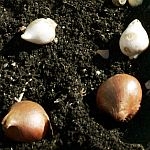Vermont Garden Journal Homepage
I’m Charlie Nardozzi and this is the Vermont Garden Journal. As the beautiful colors of autumn spread across the countryside, today I’m going to talk about tulips! Originally from Turkey and used for medicinal purposes, the tulip has become one of the most popular spring flowering bulbs in the world. In the 1600s, tulipmania hit Europe where people spent their entire life savings to buy an individual bulb. The tulip craze has waned, but I’m still crazy about growing them.
Plant tulips now in groups. Mass plant beds of all one color tulip or mixed colors. Consider unusually shaped hybrids such as the parrot, lily, and fringed tulips. I particularly like the species tulips. They are lower growing than hybrids, but have colorful, cup-shaped flowers, and more reliably come back each year compared to hybrids.
If you have limited planting space, try layering tulips with other bulbs. In well drained, loose soil, dig a hole and plant tulip bulbs about 5- to 6- inches deep. Barely cover bulbs with soil and place crocus bulbs on top of them planted 3- to 4-inches deep. Cover these bulbs and plant small bulbs such as snow drops or scilla a couple inches deep. Water well and enjoy the spring crescendo of bulbs starting with the small snow drops and ending with your tulips.
Now for this week’s tip, don’t dig all your root crops now. Leave some for a winter harvest. They’ll taste even sweeter. Cover beds in November with a 4- to 6-inch layer of hay or straw to protect roots from freezing and harvest all winter long.
Next week on the Vermont Garden Journal, I’ll be talking about garlic. For now, I’ll be seeing you in the garden!
